

By Lora Koenig
Greenbelt (MD, US), 3 January — On December 28 in Antarctica (which corresponds to Dec. 27 back here in the States), the team completed the traverse and arrived back at Byrd Camp with a warm welcome from the camp residents. In 18 days they had traveled 500 kilometers (310 miles), drilled eight ice cores, dug six 2-meter (6.56-ft) snow pits and set up and broken down six camps sites. And, I am guessing here, but I am sure they heaved over 20,000 shovels of snow and lifted over two tons per person while moving the science equipment, food and gear around. Ludo shoveled the most, digging the snowpits, and Randy lifted the most, hauling the ice core drill up and down while pulling each ice core to the surface. Most importantly, the team completed all planned science activities and returned safely.
The team arrived Byrd Camp at 10 AM and immediately started packing their gear in order to catch a flight out the next day. Yes, more lifting. It was going to be a very quick turnaround but the rule in Antarctica is, if a plane is on the ground, get on it! The team, along with the camp staff, had the pallet of gear built by the evening and got to enjoy a big meal from the Byrd Camp chefs. They found out early on the 29th that they would not be getting a plane that day — there had been a medical emergency somewhere else in Antarctica and the plane had been diverted there to help. No one is ever frustrated in situations like these; everyone just hopes for the best for whoever was in the incident and waits patiently for the next plane.
The next plane to McMurdo was scheduled for Jan. 2, 2012 (New Year’s Day in the States). This gave the team plenty of time to rest their arms and backs and recover from all their hard work, and gave the weather a chance to allow the Twin Otter at Byrd to retrieve the cached ice cores and empty fuel barrels at the camp site. The cores were collected and taken to WAIS Divide Camp, where they will stay in a freezer (a giant dug-out snow cave) until mid-January, when they will fly to McMurdo on a cold-deck LC-130 flight (a flight with the heater turned off). Once in McMurdo, the ice cores will wait in a freezer until the resupply ship reaches the station in February. Then they will be loaded into the ship’s freezer and sailed to Port Hueneme, California. At this point, they will be put in a freezer truck and driven to the lab in Provo, Utah, at Bringham Young University. The ice cores have a long journey ahead!
The team rang in 2012 at Byrd Camp, which only about 35 other people can claim they did, and on Jan. 2 they left for McMurdo, arriving very late that same day. I talked with the team briefly on the phone when they were in McMurdo, but they were very busy. There was a flight out at 2 AM on Jan. 4 that they were scheduled to leave on. They were all busy cleaning and returning gear, packing and shipping the science equipment back to the States and getting ready to leave Antarctica for Christchurch, New Zealand. I expect to hear if the team has arrived in Christchurch later today or tomorrow. If all is on schedule, the team is just leaving Antarctica and flying over the Ross Sea. Christchurch has been experiencing a swarm of earthquakes over the past few days but there has been no damage that would delay the team’s return. Once the team is settled in a location with good internet connectivity we will start posting their blog posts and images from the traverse, so stay tuned!
By Lora Koenig
McMurdo Station (Antarctica), 15 December — Today the Traverse Team traveled from SEAT Camp 2 to SEAT Camp 3. They picked up their fuel cache at Camp 3 and enjoyed the chocolate chip cookies that were inside. So far, the team has drilled three ice cores and traveled over 220 kilometers (136.7 mi). They will be at Camp 3 for at least two days to drill two ice cores in this area, which is the highest accumulation site on the traverse. The accumulation here will be close to 1 meter (3.28 feet) per year, while at Byrd is was over10 centimeters (3.9 inches) per year. The team is traveling fast and making up lost time each day.
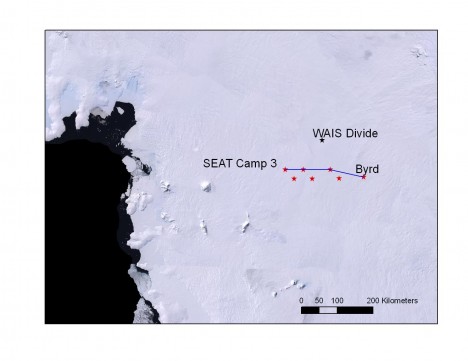
I am in McMurdo, waiting for a plane to fly back to Christchurch, New Zealand. The plane will arrive shortly after 4 AM. The C-17 planes have to land in the middle of the night because the days are already too warm, and the ice on the runway too soft, for a plane to land during daylight. So they are landing in the wee hours of the morning, which corresponds to the coldest part of the day and the hardest ice conditions. Once I get on a plane, I will be in transit for 60 hours, until I reach my home in Maryland.
I will leave Antarctica on the same plane than the Prime Minister of Norway, who was just at the South Pole to celebrate the 100th Anniversary of Ronald Amundsen being the first man to reach the South Pole. Our traverse team is still following in Amundsen’s footsteps, traveling over the ice to gain a better understanding of Antarctica.
By Lora Koenig
Byrd Station (Antarctica), 13 December — Well, I am still at Byrd Camp. One plane for the day from McMurdo has already been canceled and two more are scheduled. Byrd has not had a flight in over a week, and they are trying to get as many flights from McMurdo in as they can. There are still science teams waiting to get here. Also, the camp would like some freshies (fruits and vegetables), to increase moral. I shoveled some more today for the camp and did some house mouse choirs, which included doing the dishes, sweeping, and washing the tables. I may as well stay busy while I am waiting.
The team is traversing to Camp 2 today. They finished the ice core at Camp 1 and all the science is going well. When I last spoke with them, they were going out to locate their fuel cache, so they will have a nice loaf of bread to have with dinner tonight.
I just heard that my plane is in route, so I just may get to McMurdo tonight.
By Lora Koenig
Byrd Station (Antarctica), 11 December — We all got up at 5 AM this morning. I had gone to bed at 2 am because I had been backing up all of the radar data, which took much longer than anticipated. The traverse team went to bed early to be rested for the day.
It was a beautiful morning: warm, no wind, with thin, low, overcast clouds. The sleds were loaded and ready to go, already hooked on to the snowmobiles. Ludo was the first to the sleds and he started the generator, which powers heating pads that are used to warm the radars after being cold soaked all night. After about 15 minutes of warming, the radars can be started. During this time, the GPS is also turned on so it can obtain lock with the satellites and provide accurate positions.
I took the snowmobile covers off and helped Michelle load the final sleep kits on the sleds. The sleep kits are the last things to be loaded and contain a sleeping bag, sleeping bag liner, insolite pad, thermorest, pillow (if you want one, though most of us prefer to just use big red as a pillow), and a pee bottle so you don’t have to leave the tent in the middle of a cold night or storm. All of this is stuffed into a duffle bag and goes with you everywhere inAntarctica.
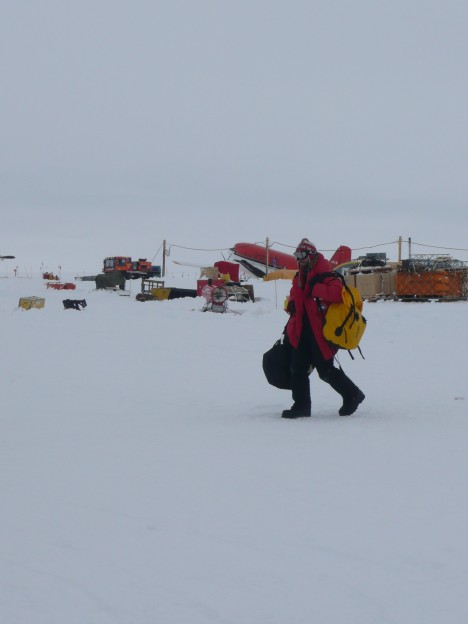
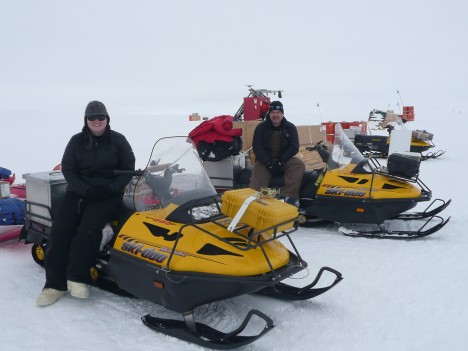
Once the generator was started, the team headed into the galley for a quick breakfast. Most of the camp was still asleep because Sunday is their day off; however, Kaija and Tony, the camp manager and assistant manager, came up to see the team off. After breakfast, the radars were turned on and the snowmobiles started. We took some final pictures and I tried to shoot some video but the small video camera we brought along is not operating well in the cold. The feeling of both excitement and nervousness was in the air. Excitement for finally getting to the traverse portion of the science and nervousness because the team is headed out into the remoteness ofAntarcticaalone. They will no longer have the security of an established camp and will have to rely on each other for everything. The team is strong and I know they will do well. During the traverse they will most certainly cover ground that no human has ever walked on before.
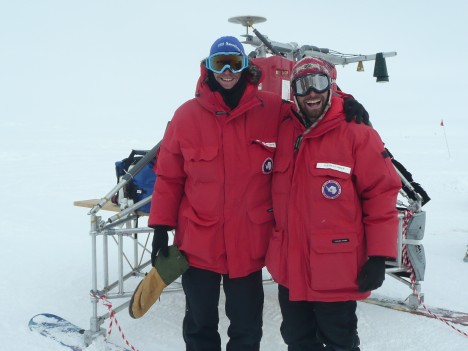
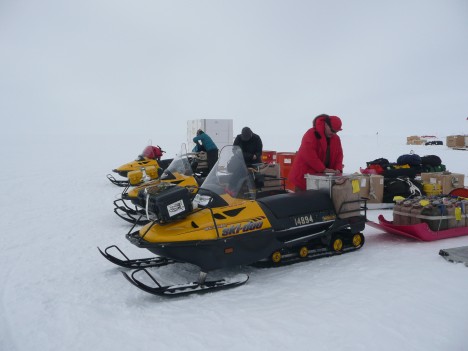
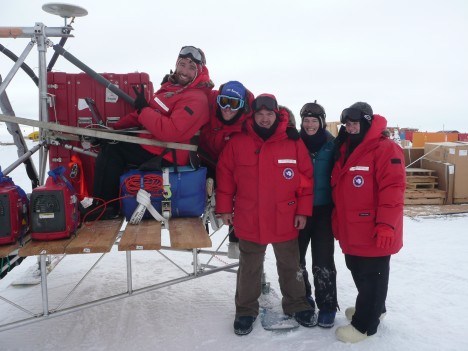
At 6:41 AM, Michelle led the team out of Byrd Camp. She pulled a Siglin sled and a Nansen sled with food, the Scott tent, an HF radio for emergency communication, the radar spare parts, the sleep kits and personal gear. Michelle rides one of the two snowmobiles with mirrors so she can easily watch the team. Jessica followed pulling 2 Siglin sleds with food, the ice core drill and two ice core boxes. Randy was third in line with two Siglin sleds with even more food, the mountain tents, emergency bag, and all of the fuel. Ludo pulled the final snowmobile out and into line pulling the radar sled with Clem on the sled operating the radar. We all screamed and waved as they pulled away.
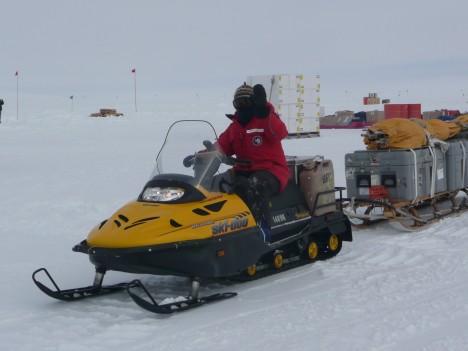
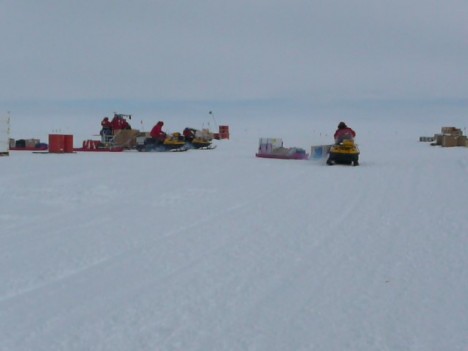

I continued to watch as they moved further towards the horizon. They became smaller and smaller dots on the horizon above tent city as they moved away from camp. At 7:12 AM their dots blurred into the horizon. The traverse had begun.

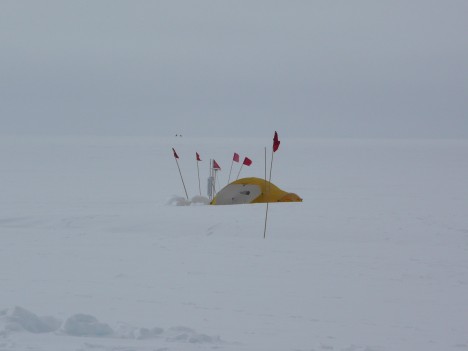
They will travel 95 km (59 mi) today, their longest stretch of the entire traverse, to the first camp site. They are moving toward higher snow accumulation and towards WAIS Divide field camp. When they reach the site tonight, they will be95 km(59 mi) from Byrd and85 km(52.8 mi) from WAIS Divide, so if they have any problems they will head to WAIS Divide, not Byrd.
I am feeling very lonely sitting in Byrd camp without the team, but there is still important work to do. Remember, the team still does not have their fuel caches. The pilots are in camp, but today’s overcast weather, while great for traversing, is not adequate for flying: The clouds make it difficult to see the snow surface. The pilots call this surface definition. In order to do open field landings (landings not on a ski way), the pilots cannot have overcast clouds at any level. Now I am just waiting for the weather to clear so that the plane can cache the team’s fuel and ice core boxes. I am also waiting for an LC-130 to come into Byrd so I can get a ride back to McMurdo and then back to the U.S.
Today I will also check the base station GPS and give a science lecture about our traverse to the Byrd Camp residents.
Everyone at Byrd Camp has helped us so we can complete our science goals and it is much appreciated. Thank you, Byrd Camp! We especially enjoyed the wonderful food made by Chef Rob. The team’s send-off dinner was duck with a port sauce, chicken with polenta, pureed carrots, broccoli with hollandaise sauce, and Boston Cream and Lemon Meringue pie for dessert. Yummmmm!
Around 7 PM tonight I expect to get a satellite phone call from Michelle. From this point on, the blog will have less pictures for a while because we will only have voice communication with the team. It should take between 24 and 30 days to complete the traverse, including (bad) weather days. The team will communicate back to me at each camp site and I will update you on their progress. When they return, we will post more posts from them with pictures of the traverse.
The team is truly out in the wilderness. The only communication they have is through the sat phone, which will only be on for a few hours in the evening. They can call their families and their families can send 160 character text messages to the sat phone. The deep field ofAntarcticais a remote place.
Go team, go!!!!!! (The extra exclamation points are for Clem, who loves to use them.)
Today, Clem and Ludo did a little science. They dragged the radar in a grid pattern around the ice core site from yesterday. This is important data because it tells us how representative the point where the ice core was drilled is of the larger area around it. When we compare ice core data to satellite data, we want to know if the larger area is homogeneous (similar) or not.
Randy made sure all the snowmobiles were ready and fueled to leave early in the morning. One of the choke leavers on a snowmobile broke off so he was working with the mechanic to get it fixed. Jessica looked at the electrical conductivity measurements from yesterday and took pictures of all of the log book pages to create a back up of the data. Michelle spent the day making sure all the gear was loaded well on the sled and that nothing was missing.
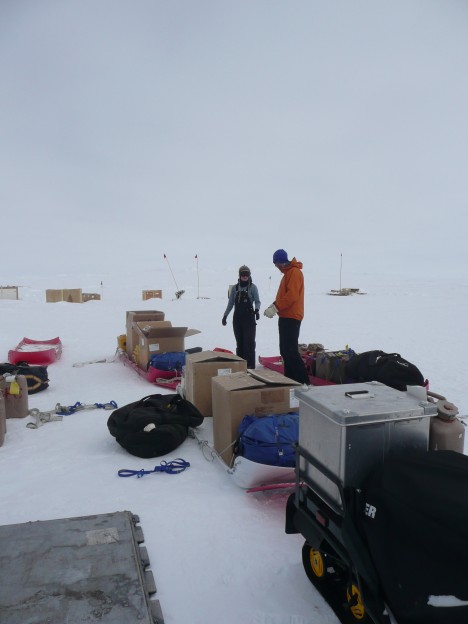
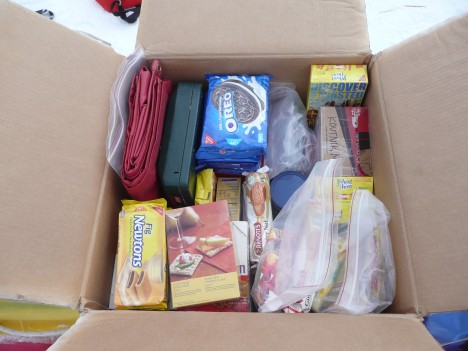
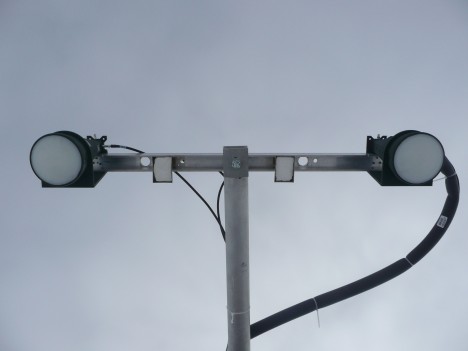
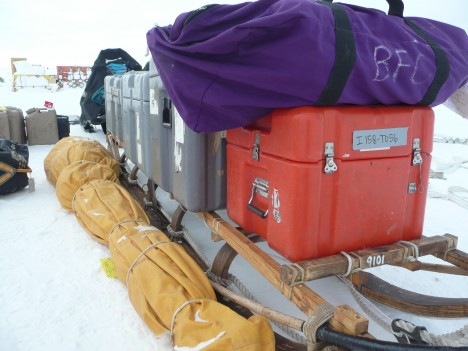
I spent most of the day watching the weather and talking with pilots. We cannot carry all of our gear on the sleds. A DC-3 Bassler aircraft is supposed to drop our fuel and ice core boxes and each camp site before the traverse. Due to the bad weather, the fuel cache has not yet been cached. So I have been talking with the pilots and rearranging the caches so the team can start out and not incur more delays. For now, the team will leave in the morning carrying two ice core boxes and one 55-gallon drum of fuel. This will allow them to get to the first camp site and drill. It will also give them enough fuel to get back to an established field camp if for some reason they don’t get any more fuel. They will not go to Camp 2 until they know the cache of fuel is there. Hopefully the cache will occur tomorrow or the next day so the traverse team will not be delayed.
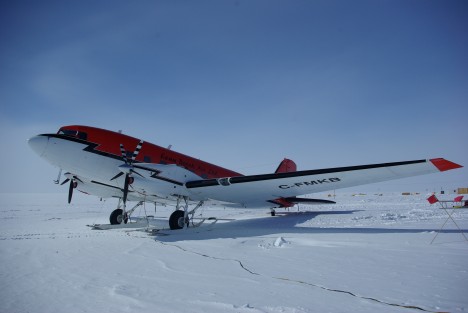
Everyone will go to sleep early tonight. Because all of Antarctica operates on McMurdo time, the time of the day at Byrd does not match the daily temperature changes. The coldest part of the day, which would generally fall from 1 to 4 AM, is usually between 6 and 10 PM our time. The warmest time falls in the morning between 6 and 10 AM. Tomorrow the team will get up at 5 AM and leave around 6 AM to take advantage of the warmest part of the day. By 6 PM they hope to be cooking dinner and in their warm tents.